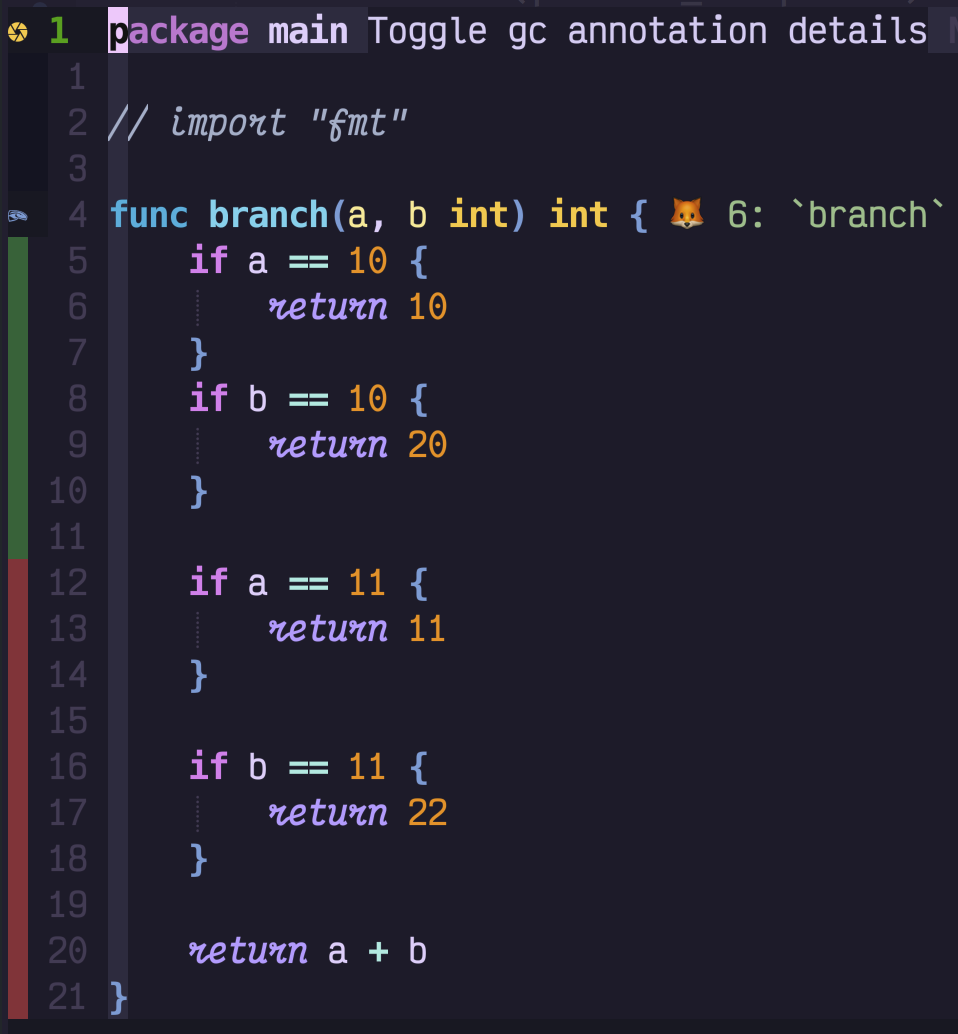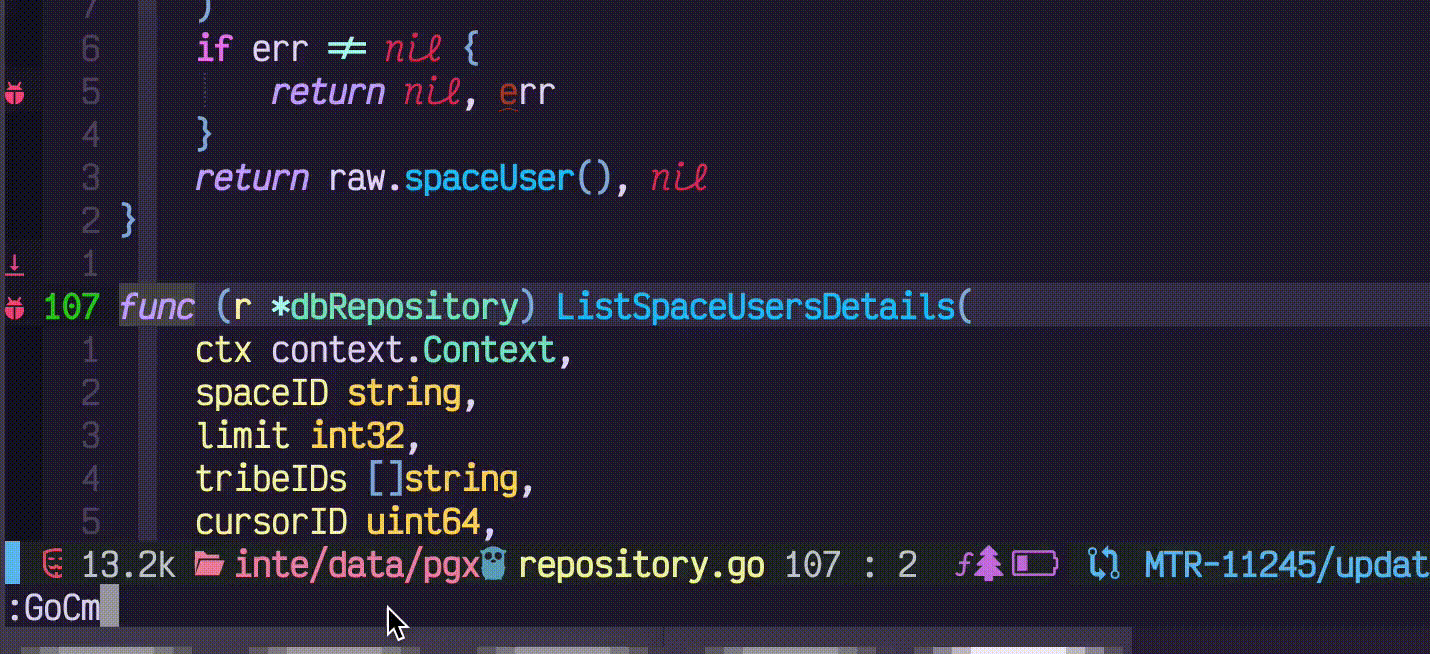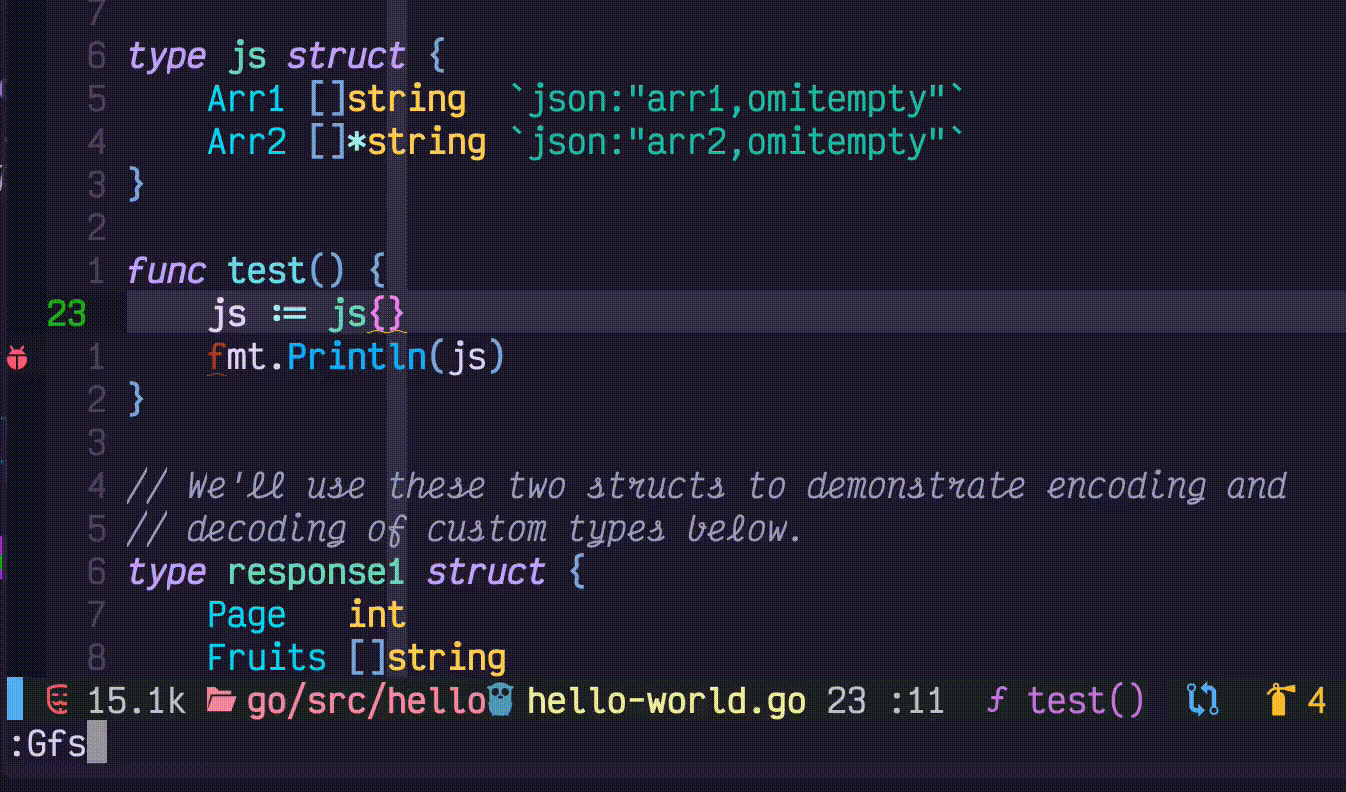| .github/workflows | ||
| lua | ||
| LICENSE | ||
| Makefile | ||
| README.md | ||
| samplevimrc.vim | ||
| TODO.md | ||
go.nvim
A modern go neovim plugin based on treesitter, nvim-lsp and dap debugger. It is written in Lua and async as much as possible. PR & Suggestions welcome. The plugin covers most features required for a gopher.
- Async jobs
- Syntex highlight & Texobject: Native treesitter support is faster and more accurate. All you need is a theme support treesitter, try aurora. Also, there are quite a few listed in awesome-neovim
- All the GoToXxx (E.g reference, implementation, definition, goto doc, peek code/doc etc) You need lspconfig setup. There are lots of posts on how to set it up. You can also check my navigator gopls setup lspconfig.lua
- Runtime lint/vet/compile: Supported by lsp (once you setup up your lsp client), GoLint with golangci-lint also supported
- Build/Make/Test: Go.nvim provides supports for these by an async job wrapper.
- Test coverage: run test coverage and show coverage sign
- Dlv Debug: with Dap UI
- Unit test: Support gotests
- tag modify: Supports gomodifytags
- Code format: Supports LSP format and GoFmt
- Comments: Add autodocument for your package/function/struct/interface. This feature is unique and can help you suppress golint errors... Go to alternative go file (between test and source)
install
make sure the $GOPATH/bin path is added to your $PATH environment variable. To check this you can run
echo $PATH | grep "$GOPATH/bin"
if nothing shows up, you can add the following to your shell config file
export PATH=$PATH:$GOPATH/bin
add 'ray-x/go.nvim' to your package manager, the dependency is treesitter (and optionally, treesitter-objects)
related binaries will be installed the first time you use it
Add format in your vimrc.
autocmd BufWritePre *.go :silent! lua require('go.format').gofmt()
To startup/setup the plugin
require('go').setup()
Screenshots
Add comments
Add/Remove tags
refactor gorename
gorename as an alternative to gopls rename as it supports rename across packages Command: GoRename
code format
nvim-lsp support goimport by default.
autocmd BufWritePre (InsertLeave?) <buffer> lua vim.lsp.buf.formatting_sync(nil,500)
The plugin provides code format, by default is goline + gofumports (stricter version of goimport)
Use following code to format go code
require("go.format").gofmt() -- format only
require("go.format").goimport() -- goimport + gofmt
To config format on save, in your init.lua:
-- Format on save
vim.api.nvim_exec([[ autocmd BufWritePre *.go :silent! lua require('go.format').gofmt() ]], false)
-- Import on save
vim.api.nvim_exec([[ autocmd BufWritePre *.go :silent! lua require('go.format').goimport() ]], false)
Auto fill
Note: auto fill struct also supported by gopls lsp-action
| command | Description |
|---|---|
| GoFillStruct | auto fill struct |
| GoFillSwitch | fill switch |
| GoIfErr | Add if err |
package foo
import "io"
func Foo() (io.Reader, error) { // the cursor on this line to add if err statement
}
Textobject
Supported by treesitter. TS provided better parse result compared to regular expression. Check my treesitter config file on how to setup textobjects. Also with treesitter-objects, you can move, swap the selected blocks of codes, which is fast and accurate.
Build and test
| command | Description |
|---|---|
| GoMake | make |
| GoBuild | |
| GoGenerate | |
| GoRun | e.g. GoRun equal to go run .; or GoRun ./cmd equal to go run ./cmd |
| GoTest | go test ./... |
| GoLint | golangci-lint |
| GoCoverage | go test -coverprofile |
Show test coverage:

Provided wrapper for gobulild/test etc with async make Also suggest to use vim-test, which can run running tests on different granularities.
Unit test with gotests and testify
Support table based unit test auto generate, parse current function/method name using treesitter
| command | Description |
|---|---|
| GoTestFunc | run test for current func |
| GoTestFunc yourtag | run test for current func with -tags yourtag option |
| GoTestFile | run test for current file folder |
| GoTestFile yourtag | run test for current folder with -tags yourtag option |
| GoAddTest | |
| GoAddExpTest | Add tests for exported funcs |
| GoAddAllTest | Add tests for all funcs |
Modifytags
Modify struct tags by gomodifytags and treesitter
| command | Description |
|---|---|
| GoAddTag | |
| GoRmTag | |
| GoClearTag |
GoFmt
nvim-lsp support goimport by default. The plugin provided a new formatter, goline + gofumports (stricter version of goimport)
| command | Description |
|---|---|
| Gofmt | goline + gofumpt |
| Goimport | goline + goimport + gofumpt |
GoImpl
generate method stubs for implementing an interface
Usage:
:GoImpl {receiver} {interface}
e.g:
:GoImpl f *File io.Reader
Debug
| command | Description |
|---|---|
| GoDebug | start debug session |
| GoDebug test | start debug session for go test file |
| GoDebug nearest | start debug session for nearest go test function |
| GoBreakToggle | |
| GoBreakCondition | conditional break |
| GoDbgStop | Stop debug session |
Swtich between go and test file
| command | Description |
|---|---|
| GoAlt / GoAlt! | open alternative go file (use ! to create if not exist) |
| GoAltS / GoAltS! | open alternative go file in split |
| GoAltV / GoAltV! | open alternative go file in vertical split |
Comments and Doc
Auto doc (to suppress golang-lint warning), generate comments by treesitter parsing result
type GoLintComplaining struct{}
And run
lua.require('go.comment').gen() -- or your faviourite key binding and setup placeholder "no more complaint ;P"
The code will be:
// GoLintComplaining struct no more complaint ;P
type GoLintComplaining struct{}
LSP
LSP supported by nvim-lsp is good enough for a gopher. If you looking for a better GUI. You can install navigator, or lspsaga, and lsp-utils etc.
LSP CodeLens
Gopls supports code lens. To run gopls code lens action GoCodeLenAct
Note: codelens need to be enabled in gopls, check default config in
Lint
Supported by LSP, also GoLint command (by calling golangcl-lint) if you need background golangci-lint check, you can configure it with ALE
Debug with dlv
Setup for Debug provided. Need Dap and Dap UI plugin
 GDB style key mapping is used
GDB style key mapping is used
Keymaps
| key | Description |
|---|---|
| c | continue |
| n | next |
| s | step |
| o | stepout |
| S | cap S: stop debug |
| u | up |
| D | cap D: down |
| C | cap C: run to cursor |
| b | toggle breakpoint |
| P | cap P: pause |
| p | print, hover value (also in visual mode) |
Commands
| Command | Description |
|---|---|
| GoDebug | Start debugger, to debug test, run Debug test, to add addition args run Debug arg1 arg2 |
| GoBreakToggle | toggle break point |
| BreakCondition | conditional break point |
| ReplRun | dap repl run_last |
| ReplToggle | dap repl toggle |
Required DAP plugins
The plugin will setup debugger. But you need to install
-
dap
- 'mfussenegger/nvim-dap'
-
dap ui (optional)
- 'rcarriga/nvim-dap-ui'
-
dap virtual text (optional)
- 'theHamsta/nvim-dap-virtual-text'
Also you can check telescope dap extension : nvim-telescope/telescope-dap.nvim
Sample vimrc for DAP
Plug 'mfussenegger/nvim-dap'
Plug 'rcarriga/nvim-dap-ui'
Plug 'theHamsta/nvim-dap-virtual-text'
" Plug 'nvim-telescope/telescope-dap.nvim'
Commands
Check go.lua on all the commands provided
configuration
Configure from lua suggested, The default setup:
require('go').setup({
goimport='gopls', -- goimport command, can be gopls[default], gofumports[deprecated] or goimport
gofmt = 'gofumpt', --gofmt cmd,
max_line_len = 120, -- max line length in goline format
tag_transform = false, -- tag_transfer check gomodifytags for details
test_template = '', -- default to testify if not set; g:go_nvim_tests_template check gotests for details
test_template_dir = '', -- default to nil if not set; g:go_nvim_tests_template_dir check gotests for details
comment_placeholder = '' , -- comment_placeholder your cool placeholder e.g. ﳑ
verbose = false, -- output loginf in messages
lsp_cfg = false, -- true: apply go.nvim non-default gopls setup, if it is a list, will merge with gopls setup e.g.
-- lsp_cfg = {settings={gopls={matcher='CaseInsensitive', ['local'] = 'your_local_module_path', gofumpt = true }}}
lsp_gofumpt = false, -- true: set default gofmt in gopls format to gofumpt
lsp_on_attach = true, -- if a on_attach function provided: attach on_attach function to gopls
-- true: will use go.nvim on_attach if true
-- nil/false do nothing
lsp_codelens = true, -- set to false to disable codelens, true by default
gopls_remote_auto = true, -- add -remote=auto to gopls
gopls_cmd = nil, -- if you need to specify gopls path and cmd, e.g {"/home/user/lsp/gopls", "-logfile",
"/var/log/gopls.log" }
lsp_diag_hdlr = true, -- hook lsp diag handler
dap_debug = true, -- set to false to disable dap
dap_debug_keymap = true, -- set keymaps for debugger
dap_debug_gui = true, -- set to true to enable dap gui, highly recommand
dap_debug_vt = true, -- set to true to enable dap virtual text
})
You will need to add keybind yourself: e.g
vim.cmd("autocmd FileType go nmap <Leader><Leader>l GoLint")
vim.cmd("autocmd FileType go nmap <Leader>gc :lua require('go.comment').gen()")
Nvim LSP setup
go.nvim provided a better non-default setup for gopls (includes debounce, staticcheck, diagnosticsDelay etc)
This gopls setup provided by go.nvim works perfectly fine for most of the cases. You can also install navigator.lua which can auto setup all lsp clients and provides a better GUI.
For diagnostic issue, you can use the default setup. There are also quite a few plugins that you can use to explore issues, e.g. navigator.lua, folke/lsp-trouble.nvim. Nvim-tree and Bufferline also introduced lsp diagnostic hooks.
Sample vimrc
The following vimrc will enable all features provided by go.nvim
set termguicolors
call plug#begin('~/.vim/plugged')
Plug 'neovim/nvim-lspconfig'
Plug 'nvim-treesitter/nvim-treesitter'
Plug 'mfussenegger/nvim-dap'
Plug 'rcarriga/nvim-dap-ui'
Plug 'theHamsta/nvim-dap-virtual-text'
Plug 'ray-x/go.nvim'
call plug#end()
lua <<EOF
require 'go'.setup({
goimport = 'gopls', -- if set to 'gopls' will use golsp format
gofmt = 'gopls', -- if set to gopls will use golsp format
max_line_len = 120,
tag_transform = false,
test_dir = '',
comment_placeholder = ' ',
lsp_cfg = true, -- false: use your own lspconfig
lsp_gofumpt = true, -- true: set default gofmt in gopls format to gofumpt
lsp_on_attach = true, -- use on_attach from go.nvim
dap_debug = true,
})
local protocol = require'vim.lsp.protocol'
EOF
This will setup gopls with non default configure provided by go.nvim (Includes lspconfig default keymaps)


